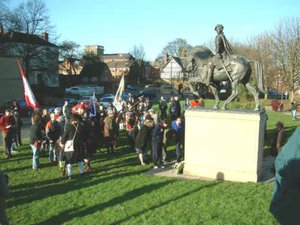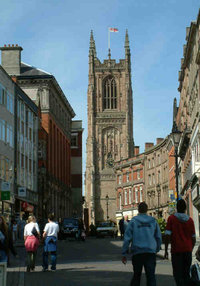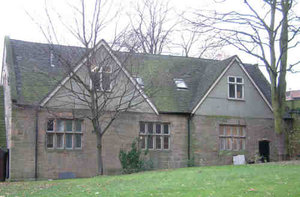Derby
|
|
- This article is about the city of Derby in England. For other meanings, see Derby (disambiguation)
| City of Derby | |
|---|---|
| Missing image EnglandDerby.png Image:EnglandDerby.png | |
| Geography | |
| Status: | Unitary, City (1977) |
| Region: | East Midlands |
| Ceremonial County: | Derbyshire |
| Area: - Total | Ranked 271st 78.03 km² |
| Admin. HQ: | Derby |
| ONS code: | 00FK |
| Demographics | |
| Population: - Total (2003 est.) - Density | Ranked 46th 233,219 2,989 / km² |
| Ethnicity: | 87.4% White 8.4% S.Asian 1.8% Afro-Carib. |
| Politics | |
Missing image Derbyarms.PNG Derby City Council http://www.derby.gov.uk/ | |
| Leadership: | Leader & Cabinet |
| Executive: | Liberal Democrats + Conservative |
| MPs: | Margaret Beckett, Bob Laxton, Mark Todd |
Derby (pronounced "dar-bee" ) is a city in the East Midlands of England. It lies on the banks of the River Derwent and is surrounded by the county of Derbyshire. Its population in 2000 was 234,905.
| Contents |
Status
Traditionally, Derby is the county town of Derbyshire, although Derbyshire's administrative centre has in recent years been Matlock. On 1 April 1997 Derby City Council became an unitary authority, with the rest of Derbyshire administered from Matlock.
History
The town has Roman, Saxon and Viking connections. The Roman camp of 'Derventio' was probably at Little Chester/Chester Green (GR SK353375); later the town was one of the 'Five Boroughs' (fortified towns) of the Danelaw.
The popular belief is that the name 'Derby' is a corruption of the Danish Deor-a-by (Village of the Deer), however some assert that it is a corruption of the original Roman name 'Derventio'. The town was also named 'Darby' or 'Darbye' on some of the oldest maps, eg. Speed's 1610 map. The city is one of the few cities that have retained a name with a Viking origin, like York, which had the Viking name of Jorvik. The city recently celebrated its 2,000th year as a settlement.
New research (throughout 2004) into the history and archaeology of Derby has provided evidence that the Vikings and Anglo-Saxons probably co-existed, occupying two areas of land surrounded by water. The saxon Chronicles (c. 900) state that "Derby is divided by Water". These areas of land were known as "Northworthy" and Deoraby, and were located at the "Irongate" (North) side of the city. Ron Mackeown of Derby Heritage Development Trust has produced a paper on this subject and his findings are already being acclaimed by the academic community.
During the Civil War of 1642-1646 the town was garrisoned by Parliamentary troops commanded by Sir John Gell, who was appointed Governor of Derby in 1643. These troops took part in the defence of Nottingham, the siege of Lichfield, the battle of Hopton Heath and many other engagements in Nottinghamshire, Staffordshire and Cheshire, as well as successfully defending Derbyshire against royalist armies.
Derby and Derbyshire were centres of Britain's industrial revolution. In 1717 Derby was the site of the first water powered silk mill in Britain, built by John Lombe and George Sorocold after Lombe had reputedly stolen the secrets of silk-throwing from Piedmont in what is now Italy (he is alleged to have been poisoned by Piedmontese in revenge in 1722).
In 1759 Jedediah Strutt patented and built a machine called the Derby Rib attachment that revolutionised the manufacture of Hose. This attachment was used on the Rev. Lee's Framework knitting machine; it was placed in front of and worked in unison with Lee's Frame, to produce ribed hose (stockings). The partners were Jedediah Strutt, William Woollatt had been joined in 1758 by John Bloodworth & Thomas Stafford, leading hosiers in Derby. The Patent was obtained in January 1759, after three years Bloodworth & Stafford were paid off and Samuel Need, hosier of Nottingham joined the partnership the firm was known as Need, Strutt & Woollatt. The Patent expired in 1773, though the partnership continued until 1781 when Need died.
Messrs Wright the bankers of Nottingham recommended that Richard Arkwright apply to Strutt & Need for finance for his Cotton Spinning Mill. The first Mill opened in Nottingham in 1770 this was driven by horses.
In 1771 Richard Arkwright, Samuel Need and Jedediah Strutt built the world's first water-powered Cotton Spinning mill at Cromford, Derbyshire, developing a form of power that was the catalyst for the industrial revolution.
This was followed in Derbyshire by Jedediah Strutt's Cotton Spinning Mills at Belper. The first, South Mill 1775, North Mill 1784 the latter destroyed by fire 12th January 1803 was rebuilt and started work again at the end of 1804,West Mill 1792 commenced working 1796, Reeling Mill 1897, Round Mill took 10 years to build 1803-1813 commenced working 1816 and Milford Mills 1778. The Belper and Milford Mills were not built in partnership with Arkwright. These mills were all Strutt owned and financed.
The Belper North Mill of 1804 built by William Strutt, Jedediah's son, is the only original Strutt Mill still standing today. It is an Iron Framed - Fire Proof Building. (Now a Visitor Centre open Wed-Sun 1pm to 5pm).
Thomas Evans' mill at Darley Abbey (1783). Other famous 18th century figures with connections to Derby include Dr Johnson, the creator of the English dictionary, who married Elizabeth Porter at St. Werburgh's Church, Derby in 1735; the painter Joseph Wright, known as Wright of Derby, who was famous for his revolutionary use of light in his paintings and was an associate of the Royal Academy; and John Whitehurst, a famous clockmaker and philosopher. Erasmus Darwin, doctor, scientist, philosopher and grandfather of Charles Darwin was also to be found in Derby and Derbyshire at much the same time, though his practice was based in Lichfield, Staffordshire.
Bonnie Prince Charlie held camp at Derby on December 4th 1745, whilst on his way south to seize the English crown. The Prince called at The George Inn on Irongate, where the Duke of Devonshire had set up his headquarters, and demanded billetts for his 9000 troops. He stayed at Exeter House, Exeter Street where he held his "Council of War". He had received misleading information about an army coming to meet him south of Derby. although he wished to continue with his quest, he was overruled by his fellow officers. He abandoned his invasion at Swarkestone Bridge, on the River Trent, just a few miles south of Derby.
Derby was awarded city status in 1977 by Queen Elizabeth II to mark the 25th anniversary of her ascension to the throne. Prior to that, Derby was one of the very few towns in England that remained a town but boasted a cathedral.
On February 17, 2003, Derby was granted Fairtrade City status.
Landmarks
Derby Cathedral boasts the second-highest cathedral tower in the country.
Derby Heritage Centre, formerly the Tudor Grammar School, tells the story of Derby from Roman times till today. Derby Gaol is a visitor attraction based in the dungeons of the Derbyshire County Gaol which dates back to 1756.
Derby Industrial Museum is situated in Derby Silk Mill and shows the industrial heritage and technological achievement of Derby, including Rolls Royce aero engine, railways, mining, quarrying, foundries etc.
Pickford_expo.jpg
Pickford's House Museum was built by architect Joseph Pickford in 1770. It was his home and business headquarters. Derby Museum and Art Gallery shows paintings by Joseph Wright, as well as fine Royal Crown Derby porcelain, local regiments and archaeology.
Much of the skyline of the inner city changed radically when the inner ring road with its two new crossings of the River Derwent was built. Thus the editor (Elizabeth Williamson) of the 2nd edition of Pevsner for Derbyshire wrote:- '...the character and cohesion of the centre has been completely altered by the replacement of a large number of C18 houses in the centre by a multi-lane road. As a traffic scheme this road is said to be a triumph; as townscape it is a disaster.'
Industry
Derby's two biggest employees, Rolls-Royce plc and the Toyota Motor Corporation, are both in the manufacturing trade. Egg, the Internet and telephone bank, has its national base in Derby.
Derby was for many years a significant railway centre, with both British Rail workshops and research facilities in the town. The town was also formerly the centre for the Midland Railway. Although the facilities are now largely moribund, Derby station retains an important strategic role in the rail network.
Culture, entertainment and sport
Woodywalk.jpg
The annual open-air concert at Darley Park is one of the biggest free concerts of its kind. The Derby Jazz group caters for the jazz interest in the city and is regarded as one of the UK's leading live jazz organizations.
Derby Arboretum was the first public park in the country, though it has been somewhat neglected in recent years.
Pride_Park_Stadium_inside.jpg
Other famous Derby institutions include Derby County Football Club, currently playing in the Football League Championship. Derby County won the First Division title (then the highest achievement in English football) in 1972 and 1975. The Rams, as Derby County are known, also won the FA Cup in 1946.
Education
Like most of the UK, Derby operates a non-selective primary and secondary education system with no middle schools. Students attend infant and junior school (often in a combined primary school) before moving onto a comprehensive secondary school. Many secondaries also have sixth forms, allowing students to optionally continue their education by taking A Levels after the end of compulsory education at age 16. For those who want to stay in education but leave school, the large Derby College provides a number of post-16 courses.
Outside of the state sector, there are two fee-paying independent schools, Derby Grammar School, which caters for boys and considers itself a continuation of Derby School (which was one of the oldest schools in the country), and Derby High School, which caters for girls (and also boys at primary level only).
The University of Derby is the city's university.
Media
The Derby Evening Telegraph is the city's daily newspaper. In addition, two free newspapers, the Derby Trader and Derby Express, are delivered to households weekly.
BBC Radio Derby, the BBC's local station for the area, consists mainly of news, features and sports commentaries. Ram FM is the commercial alternative, playing inoffensive pop music.
Towns and villages
- Allenton, Allestree, Alvaston
- Boulton, Breadsall Hilltop
- Chaddesden, Chellaston, Crewton
- Darley Abbey
- Heatherton Village
- Little Chester, Littleover
- Mackworth Estate, Markeaton, Mickleover
- Normanton
- Oakwood, Osmaston
- Peartree
- Rose Hill
- Shelton Lock, Strutt's Park, Spondon
- Wilmorton
Places of interest
- Darley Abbey
- Derby Cathedral
- Derby Industrial Museum (Silk Mill)
- Alvaston Park
- Elvaston Castle
- Derby Arboretum
- River Derwent
- Markeaton Park Light Railway, a heritage railway
- Pride Park Stadium
| Districts of England - East Midlands | 
|
|
Amber Valley | Ashfield | Bassetlaw | Blaby | Bolsover | Boston | Broxtowe | Charnwood | Chesterfield | Corby | Daventry | Derby | Derbyshire Dales | East Lindsey | East Northamptonshire | Erewash | Gedling | Harborough | High Peak | Hinckley and Bosworth | Kettering | Leicester | Lincoln | Mansfield | Melton | Newark and Sherwood | Northampton | North East Derbyshire | North Kesteven | North West Leicestershire | Nottingham | Oadby and Wigston | Rushcliffe | Rutland | South Derbyshire | South Holland | South Kesteven | South Northamptonshire | Wellingborough | West Lindsey | |
|
Administrative counties with multiple districts: Derbyshire - Leicestershire - Lincolnshire - Northamptonshire - Nottinghamshire |



